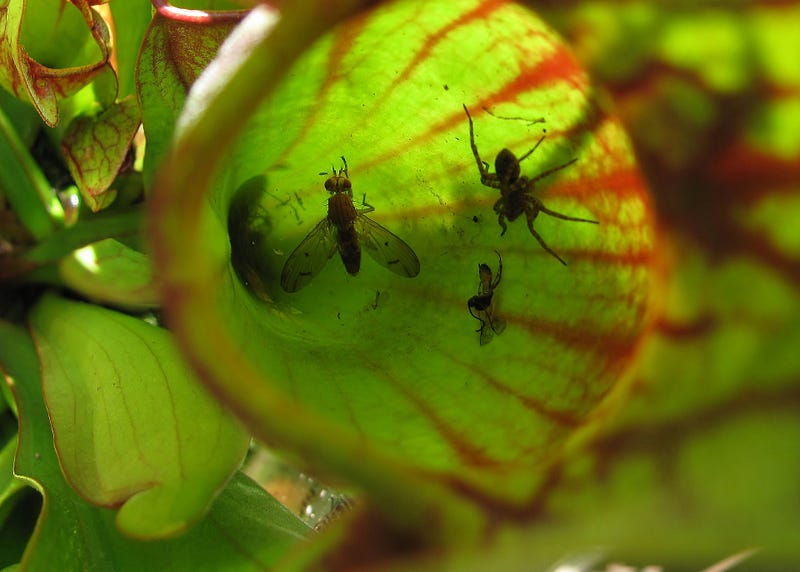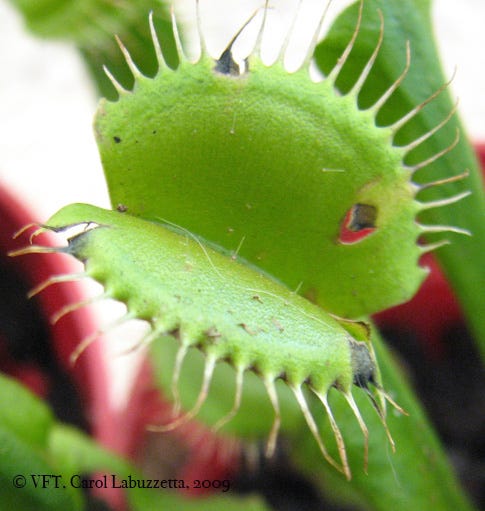Carnivorous Plants: A Fascinating Journey Through Nature
Written on
Chapter 1: Introduction to Carnivorous Plants
During my years leading an after-school garden club for elementary students, I sought out engaging topics that would spark their curiosity. One day, I stumbled upon a carnivorous plant at a local nursery and immediately thought it would be an excellent subject. Eager to share this fascinating topic, I dove into research from reliable sources. This led to the development of a unit on carnivorous plants that I introduced to my students aged 7–12. For the next decade, this unit became a staple, captivating students year after year.

We explored various carnivorous plants, including Venus Flytraps, Pitcher Plants, Bladderworts, and Sundews, examining the unique characteristics of each. You might be surprised to learn that beyond the well-known Venus Flytrap, several other plants have adapted to capture their food—an intriguing subject indeed!
Section 1.1: The Venus Flytrap
The Venus Flytrap, scientifically known as Dionaea muscipula, is the sole species of its kind. Native to the marshy wetlands of North and South Carolina, these plants have adapted to survive in nutrient-poor, sandy soils by luring and capturing small prey such as flies. The leaves are equipped with trigger hairs that, when touched in quick succession by an insect, cause the trap to snap shut, trapping the unsuspecting victim. The plant then secretes digestive juices to break down the insect, allowing it to absorb essential nutrients.
Venus Flytraps are classified as snap traps, closing rapidly when an insect enters. They emit a scent that mimics food to attract their prey. Once the trap closes, it remains shut for about ten days, digesting the insect before reopening, a process that can only occur a limited number of times before the leaves die off.
While the Venus Flytrap gained fame from the movie "Little Shop of Horrors," it's important to note that they do not require human feeding; they effectively catch their prey independently. They are also delightful to grow, especially for children. Unfortunately, these plants face threats from poaching, and it is illegal to remove them from their natural habitats. However, they are widely available in stores, with prices typically around $11.99. It's essential to follow care instructions to keep them healthy; I’ve managed to sustain some for 3–4 years in a humid terrarium setup.
This engaging video showcases the feeding habits of Venus Flytraps and Pitcher Plants, providing a visual exploration of their unique adaptations.
Section 1.2: Pitcher Plants
Wisconsin, while lacking native Venus Flytraps, does host another intriguing carnivorous plant: the Northern Pitcher Plant. These plants thrive in nutrient-deficient marshy environments, such as fens and bogs. Unlike Venus Flytraps, Pitcher Plants are passive carnivores. They do not actively move to capture prey; instead, they rely on attractive colors, scents, and shiny surfaces to lure insects.
Once an insect approaches the opening of the pitcher, it often slips inside, unable to escape due to the downward-pointing hairs and slippery walls. At the base, a watery fluid filled with bacteria and fungi helps to digest the trapped insects. As the insects decompose, they release nutrients that the plants utilize for their growth.
Pitcher Plants are distributed globally in humid areas, with some species large enough to ensnare small animals like frogs and lizards. Despite Wisconsin having only one native species, the Pitcher Plant remains a captivating subject for students.
Chapter 2: The Sundew Plant
Another carnivorous plant found in Wisconsin is the Round-Leaved Sundew, or Drosera rotundifolia. This unique plant captures its prey with sticky, glistening hairs that resemble nectar. When an insect lands on these hairs, it becomes ensnared, and the plant's leaves gradually curl around it. Enzymes are released, slowly killing the insect and allowing the plant to absorb its nutrients. Once the nutrients are extracted, the plant discards the remaining exoskeleton and prepares to ensnare its next meal.
Like other carnivorous plants, Sundews thrive in wet, bog-like environments that lack traditional sources of nutrition.
Carnivorous plants present an exciting opportunity for children and plant enthusiasts alike. I once created a Kahoot quiz for a fifth-grade class, allowing students to engage with the material in a fun way. You can check it out and test your knowledge!

Sources:
- Venus flytrap | Description, Mechanism, Adaptations, Habitat, Diet, & Facts. www.britannica.com
- Door County Pulse: Door to Nature: Carnivorous Plants (2019)
If you enjoyed this article, consider supporting my writing on Medium.com. You can join for just $5.00 per month, gaining access to my articles and many others. I appreciate your support!